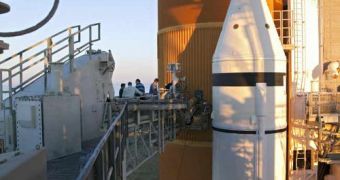Officials at the American space agency announce that the launch of space shuttle Discovery has been postponed to no earlier than February 2011, due to the severity of the damages found on the orbiter's external fuel tank.
Taking off with that many cracks in the massive orange tank would equal suicide, experts say. As such, mission controllers and top shuttle officials decided to give repair crews and engineers ample time to fix all the cracks they come across.
This is but the last one in a line of delays that have been affecting Discovery since late October, when it was rolled out to Launch Pad 39A, at the Kennedy Space Center (KSC), in Florida.
It was originally planned to launch on November 1, but tests and ground workers discovered a series of glitches in its engine computers and fuel lines, as well as some cracks in the large EFT.
Over subsequent weeks, NASA continued to delay the launch, and did so again yesterday, after a series of meetings took place among top officials. Delaying the shuttle's launch into next year was one of the things they tried to avoid at all costs, but apparently they couldn't avoid it.
NASA engineers now say they will need at least until February 3 to carry out the necessary repairs, and to analyze the fuel tank in detail. They are looking for other small cracks in its surface, as these that may develop and rupture during launch.
“The teams have done a very thorough job of looking at the data at hand, but we're coming to a point in the investigation where we have to do something different,” Bill Gerstenmaier, the space operations chief at NASA, said in a December 3 statement.
The new launch window will be open between February 3-10, experts say. This means that Endeavor, originally scheduled to carry out its last mission on February 27, will most likely take off in early April.
“We're at a point where there's no obvious answer as to what occurred, and what that means is that we have to take the next step,” explains the NASA space shuttle program manager, John Shannon.
“We have to do that through demonstration. Analysis is not going to get us there. Analysis can only get you so far – it's time to go test,” he goes on to say.
“We have to go to that next level and really understand the problem. This will also help determine what our screening criteria [are] to fly the tank confidently,” the official adds.
From a budget standpoint, the new delays do not raise the costs of operating the shuttle considerably, KSC experts say. Therefore, repair workers are now under pressure to conduct their investigations hastily, Space reports.

 14 DAY TRIAL //
14 DAY TRIAL //